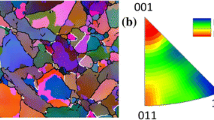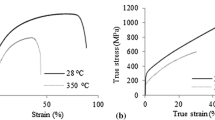Abstract
The flow stress of polycrystals is controlled by the processes occurring in the grain interior as well as in the mantle, i.e. at the grain boundary and its immediate vicinity. The early stages of evolution of dislocation substructure in these two regions with strain in 316L stainless steel polycrystals have been studied at 293 K, 673 K and 1123 K representing the low temperature thermal, the intermediate temperature athermal and the high temperature thermal regimes respectively. Specimens with grain sizes of 4 and 12 μm were employed to determine the effect of grain size.
Transmission electron microscopy studies on deformed specimens show the different roles of grain boundary and grain interior in different temperature regimes. In the low temperature regime grain boundaries act as obstacles to moving dislocations and as such high density of dislocation is found in the grain boundary vicinity. In the intermediate temperature regime the dislocations which are easily spread into the grain interior rearrange to form cell walls. In the high temperature regime grain boundaries transform to the equilibrium state and do not contain any grain boundary dislocations, and the distribution of dislocations within grains is homogeneous at all strains. Significantly higher values of dislocation densities in the vicinity as well as in the grain interior were found in the finer grain size material in the whole strain region employed.
Similar content being viewed by others
References
T. Malis andK. Tangri,Acta Metall. 27 (1979) 25.
S. Sangal andK. Tangri,Metall. Trans. 20A (1989) 479.
L. E. Murr,ibid. A6 (1975) 505.
K. J. Kurzydlowski, S. Sangal andK. Tangri,ibid. 20A (1989) 471.
L. E. Murr andS. H. Wang,Res. Mechanica 4 (1982) 237.
B. P. Kashyap, K. McTaggart andK. Tangri,Phil. Mag. A57 (1988) 97.
F. C. Bell andD. E. Sonon,Metallography 9 (1976) 91.
M. Janeček andK. Tangri,Mat. Sci. Engng A138 (1991) 237.
C. S. Smith andL. Guttman,Trans. Metall. Soc. AIME 197 (1953) 81.
R. Varin andK. Tangri,Metall. Trans. A12 (1981) 1859.
Y. Ishida, T. Hasegawa andF. Nagata,Trans. J. Inst. Metals 9 (1968) 504.
P. H. Pumphrey andH. Gleiter,Phil. Mag. A30 (1974) 593.
W. Lojkowski andK. Grabski,Scripta Metall. 13 (1979) 511.
T. Johannesson andA. Tholen,Metal. Sci. 6 (1972) 189.
R. Z. Valiev, V. Y. Gertsman andO. Kaibyshev,Phys. Stat. Sol. a97 (1986) 11.
L. E. Murr,Mat. Sci. Engng 51 (1981) 79.
T. Leffers, in “Deformation of polycrystals: Mechanisms and microstructures”, edited by N. Hansen, A. Horsewell, T. Leffers and H. Lilhot (Roskilde: Risø National Laboratory, 1981) p. 55.
J. J. Hauser andB. Chalmers,Acta Metall. 9 (1961) 802.
Author information
Authors and Affiliations
Rights and permissions
About this article
Cite this article
Janeček, M., Tangri, K. The influence of temperature and grain size on substructure evolution in stainless steel 316L. J Mater Sci 30, 3820–3826 (1995). https://doi.org/10.1007/BF01153940
Received:
Accepted:
Issue Date:
DOI: https://doi.org/10.1007/BF01153940




